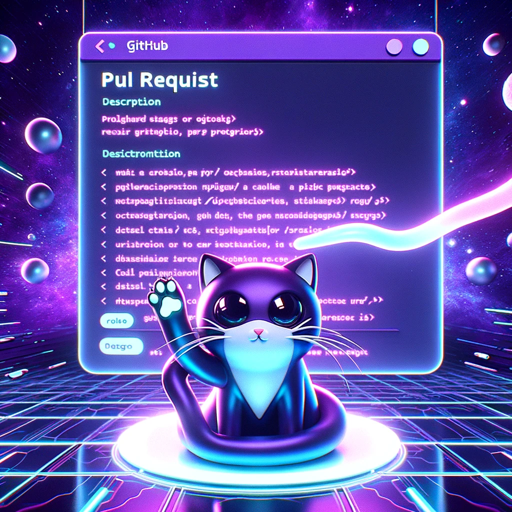PR Helper-tool for optimized PR writing
AI-powered helper for pull requests
How should I format this pull request title?
Can you help improve my PR description?
Guide me on using conventional commits.
Is this PR title following commitlint rules?
Related Tools
Load More
GitHub助手
专业解读 GitHub 上的知识和资料

Velo Helper
Direct code provider for Wix Velo API, offering exact code and file placement.

Public Relations Expert
Manages digital public relations campaigns, prepares press releases, and handles crisis communication strategies.

Next js Helper
GPT 4 powered with Next Js 14 documentation and best coding practices pdfs

Pull Request Scribe
I craft engaging Github Pull Request descriptions.

PR Creative Director
Get help from a highly creative PR director. They can provide creative help to the user across a whole range of PR activity - from PR messages, campaign ideas, messaging, image and video storyboard concepts
20.0 / 5 (200 votes)
Introduction to PR Helper
PR Helper is a specialized tool designed to assist developers in writing clear, structured, and effective pull request titles and descriptions. Its primary goal is to ensure that the pull requests (PRs) follow the Conventional Commits and commitlint standards, widely used in software development to maintain a clean and understandable commit history. By prompting developers to describe the changes they've made and then refining those descriptions into a format that aligns with these industry standards, PR Helper simplifies the process of writing high-quality PRs. This is especially important for large, collaborative projects where consistent commit messages are crucial for readability and traceability. For example, if a developer submits a PR that updates a login feature, PR Helper would encourage the developer to specify exactly what was changed, such as 'fixing authentication issues with OAuth tokens.' PR Helper would then format this input into a proper commit message structure like: `fix(auth): resolve OAuth token issues in login functionality`.

Main Functions of PR Helper
Commitlint & Conventional Commit Compliance
Example
A developer submits a pull request with a title that reads, 'Fixed bug in user login.' PR Helper would suggest a more compliant version: `fix(login): resolve incorrect redirect after user login`.
Scenario
This function ensures that all commits adhere to Conventional Commits formatting, helping maintain consistency across a project. It automatically prompts the developer to use correct prefixes (e.g., 'fix', 'feat', 'docs'), ensuring that future code reviewers and maintainers can easily understand the nature of each commit.
Clarifying Developer Intent
Example
A developer describes their changes vaguely: 'Made some updates to the UI.' PR Helper would ask for more specific details, such as 'Which components were updated? Was it a bug fix or a feature enhancement?' Based on the clarification, it would refine the description to: `feat(UI): updated button style and alignment on the dashboard for improved UX`.
Scenario
This function helps avoid ambiguous or generic descriptions. Developers are guided to provide clear, actionable descriptions that future collaborators can easily understand. This increases productivity and reduces back-and-forth communication during code reviews.
Project-Specific Customization
Example
On a project where specific modules have predefined prefixes (e.g., `ui`, `api`, `auth`), PR Helper can be customized to enforce these prefixes in PR titles. If a developer submits a PR titled 'Added new endpoint,' it might suggest: `feat(api): add new user registration endpoint`.
Scenario
This allows projects to enforce their own conventions on top of general commitlint rules. Teams working in highly modular systems or with microservices architectures benefit from this, ensuring that every PR is tagged with the appropriate module or service prefix.
Ideal Users of PR Helper
Software Development Teams
Development teams working on collaborative projects are the primary users of PR Helper. These teams typically have multiple contributors, making it essential to maintain a clean and standardized commit history. PR Helper ensures that all PRs are structured consistently, improving overall productivity by reducing ambiguity during code reviews and making it easier to track changes over time.
Open-Source Contributors
Contributors to open-source projects often have to follow strict contribution guidelines. PR Helper ensures that these contributors can easily meet those guidelines, offering real-time feedback on their PR descriptions. This helps maintainers of open-source projects by reducing the burden of correcting poorly formatted or unclear PRs, leading to faster and smoother project management.

How to Use PR Helper
1
Visit aichatonline.org for a free trial without login, no need for ChatGPT Plus.
2
Familiarize yourself with the conventional commit format, focusing on how to structure pull requests and commit messages with clarity and professionalism.
3
Input the project’s name and provide an initial draft of your PR or commit message, highlighting the changes you’ve made in your own words.
4
PR Helper will refine your input, ensuring your message adheres to professional standards and commitlint guidelines, while retaining the original intent.
5
Review the suggestions made, make any final adjustments, and then apply the refined PR or commit message to your project repository.
Try other advanced and practical GPTs
FactGPT
AI-powered accuracy for every inquiry.

Corrector de textos.
AI-powered Spanish text correction.

Biblical Explorer
AI-powered biblical exploration redefined.

Impresión 3D a tu servicio
AI-powered 3D printing assistance

RP Wizard
AI-Enhanced Role-Playing Assistant
Real Estate Counsel
AI-powered tool for real estate documents
Machine Learning Master
AI-powered guidance for machine learning success

Nordic Translator
AI-powered translations between Swedish and Finnish.

Test Case Generator
AI-powered test case generation for web and API.

Just F**king do it
AI-powered tool for quick solutions.

CBT Coach Pro: Guided Self-Improvement
AI-powered CBT tool for personal growth.

General Surgery GPT
AI-powered insights for general surgery

- Automation
- Code Review
- Team Collaboration
- Software Development
- Version Control
Detailed Q&A about PR Helper
What is PR Helper, and what does it do?
PR Helper is an AI-driven tool designed to help developers craft clear, concise, and properly formatted pull requests and commit messages. It ensures adherence to conventional commit standards and commitlint, making collaboration and version control smoother.
Who can benefit from using PR Helper?
PR Helper is ideal for software developers, project managers, and teams who want to streamline their PR processes, maintain consistent commit message standards, and improve clarity in their repositories.
Do I need to be familiar with conventional commit formats to use PR Helper?
While prior knowledge of conventional commits can be helpful, it’s not required. PR Helper guides you through the process and refines your messages to fit the correct format automatically.
How does PR Helper improve my workflow?
PR Helper saves time by structuring your commit messages and PR descriptions, ensuring they are professional, easy to understand, and formatted according to industry standards, reducing back-and-forth communication.
Can PR Helper assist with large or complex pull requests?
Yes, PR Helper is built to handle both small and large pull requests. For more complex PRs, it helps break down changes into digestible segments, ensuring each part of the update is clearly documented and easy to review.